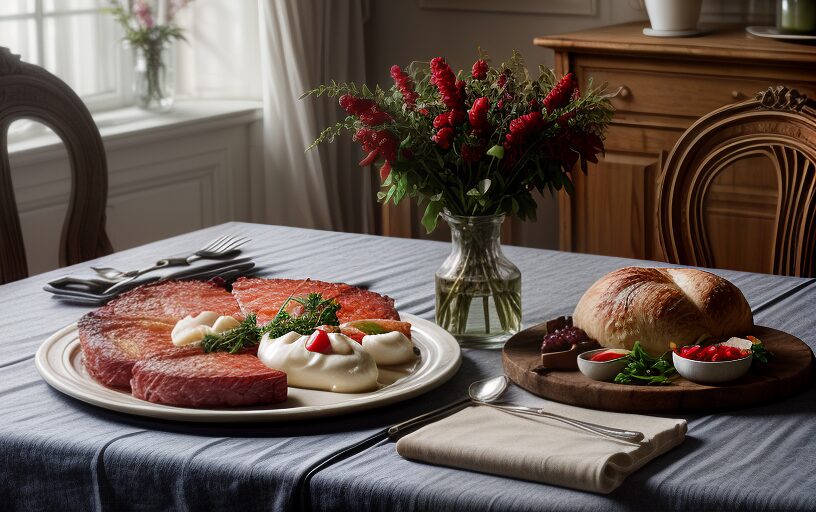Topic
Coq au Vin: A Culinary Masterpiece
History
Coq au Vin, translating to “rooster in wine,” is a quintessential French dish with roots deep in the country’s rural past. Traditionally, this dish was made using an old rooster, which required slow cooking to tenderize the tough meat. The origin of Coq au Vin is often linked to the Burgundy region, famous for its robust red wines. However, various regions in France have their own versions, using local wines and ingredients.
Recipe
Ingredients:
- 1 large rooster or chicken (about 4 pounds), cut into pieces
- 1 bottle of red Burgundy wine (about 750 ml)
- 200 grams of bacon lardons
- 2 carrots, sliced
- 1 onion, chopped
- 2 cloves garlic, minced
- 1 bouquet garni (thyme, bay leaf, and parsley)
- 200 grams of mushrooms, sliced
- 20 small pearl onions, peeled
- 2 tablespoons of tomato paste
- 2 tablespoons of all-purpose flour
- Salt and pepper to taste
- 2 tablespoons of butter
- Fresh parsley, chopped, for garnish
Instructions:
- Marinate the Chicken: Place the chicken pieces in a large bowl. Pour the wine over the chicken, add the carrots, chopped onion, garlic, and bouquet garni. Cover and refrigerate for at least 12 hours, preferably overnight.
- Cook the Bacon: In a large Dutch oven or heavy-bottomed pot, cook the bacon lardons over medium heat until crisp. Remove with a slotted spoon and set aside, leaving the fat in the pot.
- Brown the Chicken: Remove the chicken pieces from the marinade (reserve the marinade) and pat dry with paper towels. Brown the chicken in batches in the bacon fat until golden on all sides. Remove and set aside.
- Sauté the Vegetables: In the same pot, add the sliced mushrooms and pearl onions. Cook until browned, then set aside with the bacon.
- Prepare the Sauce: Sprinkle the flour over the remaining fat in the pot, stirring to create a roux. Slowly add the reserved marinade, stirring constantly to avoid lumps. Add the tomato paste and bring to a boil.
- Combine and Simmer: Return the chicken, bacon, and vegetables to the pot. Add salt and pepper to taste. Cover and simmer on low heat for about 1.5 to 2 hours, until the chicken is tender.
- Finish and Serve: Before serving, adjust the seasoning if necessary. Garnish with fresh parsley and serve hot, accompanied by crusty French bread or buttery mashed potatoes.
Other Classic French Dishes
Ratatouille
History: Originating from Provence, Ratatouille is a vibrant vegetable stew that showcases the flavors of Mediterranean France. It’s traditionally a summer dish, taking advantage of the season’s bounty.
Recipe: Sauté eggplant, zucchini, bell peppers, onions, and tomatoes in olive oil with garlic and herbs de Provence. Simmer until tender and melded together, and serve warm or at room temperature.
Boeuf Bourguignon
History: Another Burgundy classic, Boeuf Bourguignon is a rich beef stew braised in red wine, often Burgundy, with onions, garlic, carrots, and mushrooms.
Recipe: Brown beef chunks, sauté vegetables, and combine with red wine, beef stock, and bouquet garni. Simmer slowly for hours until the meat is fork-tender. Serve over mashed potatoes or with buttered noodles.
Quiche Lorraine
History: Hailing from the Lorraine region, this savory pie traditionally features a filling of eggs, cream, and lardons (bacon).
Recipe: Prepare a flaky pie crust, fill with a mixture of beaten eggs, heavy cream, crisped lardons, and season with nutmeg, salt, and pepper. Bake until the filling is set and the top is golden brown.
Conclusion
French cuisine is a celebration of taste, technique, and tradition. Whether you’re braising a rooster in red wine or baking a quiche, these classic dishes offer a window into the rich culinary tapestry of France. By embracing these recipes and their histories, we keep alive a culinary legacy that continues to inspire and delight food lovers around the world. Bon appétit !
Search Here
Topics
French Cuisine
- Traditional French Dishes
- French Pastry Techniques
- Regional French Foods
- French Cooking Schools
- French Chefs and Their Influence
- French Food Markets
- French Wine Pairings
- French Cheese Guide
- French Sauces and Condiments
- Contemporary French Cuisine
- French Seafood Traditions
- French Desserts and Sweets
- French Culinary Techniques
- French Vegetarian Dishes
- French Street Food
- French Kitchen Essentials
- The Influence of French Cuisine Abroad
- French Cooking Shows and Media
- The Business of French Food
- French Gourmet Products
French Fashion
French Wine
French Art and Artists
French Cuisine
French Cuisine
French Tourism
French Technology and Innovation
French Cinema
French Music and Performing Arts
French Cuisine
French Education System
French Political History
French Culinary Techniques
French Sports and Leisure
French Festivals and Traditions
French Business Practices
French Agricultural Products
French Architecture
French Environmental Initiatives
FAQ Section
Your Title Goes Here
Your content goes here. Edit or remove this text inline or in the module Content settings. You can also style every aspect of this content in the module Design settings and even apply custom CSS to this text in the module Advanced settings.
Your Title Goes Here
Your content goes here. Edit or remove this text inline or in the module Content settings. You can also style every aspect of this content in the module Design settings and even apply custom CSS to this text in the module Advanced settings.
Your Title Goes Here
Your content goes here. Edit or remove this text inline or in the module Content settings. You can also style every aspect of this content in the module Design settings and even apply custom CSS to this text in the module Advanced settings.
Your Title Goes Here
Your content goes here. Edit or remove this text inline or in the module Content settings. You can also style every aspect of this content in the module Design settings and even apply custom CSS to this text in the module Advanced settings.
